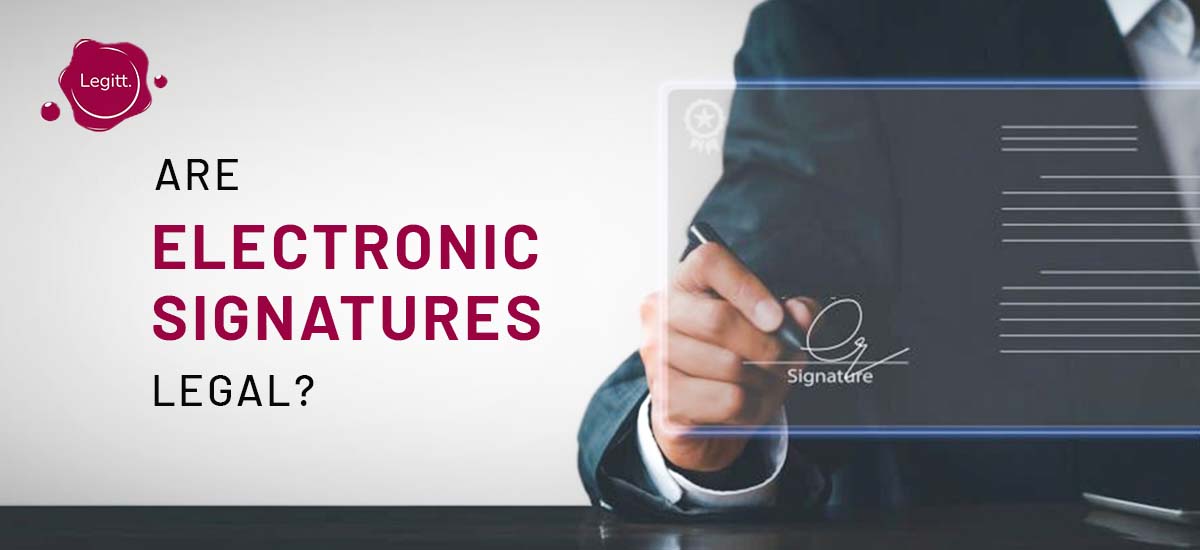Electronic signatures have become increasingly popular in recent years due to the convenience they offer when it comes to signing and executing contracts and other legal documents. However, many people still wonder whether electronic signatures are legally binding. In this article, we will explore the legal status of electronic signatures, how they work, and what factors determine their validity.
An electronic signature is a digital representation of a person’s signature. It can be created in various ways, such as by typing your name, drawing your signature on a touchscreen device, or using specialized software to generate a digital signature. Electronic signatures are often used to sign documents such as contracts, agreements, and other legal documents.
Also Read: Signature guarantee vs notary
What Makes an Electronic Signature Legally Binding?
The Electronic Signatures in Global and National Commerce Act (ESIGN) was passed by the United States federal government in 2000, and it, together with the Uniform Electronic Transactions Act (UETA), establishes that electronic signatures are legally binding documents if all parties opt to sign digitally.
E-signatures encompass the entire spectrum of technologies and methods for creating electronic signatures, from basic photographs of a signature appended to an electronic document through PKI-based signatures. A multitude of capturing methods are available, including:
- On a webpage, clicking “I Agree”
- Using your finger to sign on a mobile device
- Filling out an online form with your name or PIN
- Using an electronic signature solution such as DocuSign eSignature
Also Read: Can I notarize for a family member in NY
Are Electronic Signatures Valid?
Yes, electronic signatures are legally binding in most countries, including the United States, Canada, the United Kingdom, and many others. In the United States, electronic signature clauses are governed by the Electronic Signatures in Global and National Commerce Act (ESIGN) and the Uniform Electronic Transactions Act (UETA).
ESIGN was enacted in 2000 to ensure that electronic signatures are legally binding, recognized and enforceable in the same way as traditional paper signatures.
UETA, which has been adopted by most states, provides a framework for the use of acceptable electronic signatures in transactions. It also establishes the legal equivalence between electronic and traditional signatures.
In the United Kingdom, creating electronic signatures is governed by the Electronic Communications Act 2000 and the Electronic Identification and Trust Services for Electronic Transactions Regulations 2016. These laws provide a similar framework for the use of electronic signatures as in the United States.
In Canada, electronic signatures are governed by the Personal Information Protection and Electronic Documents Act (PIPEDA) and the Uniform Electronic Commerce Act (UECA). These laws establish the legal validity of electronic signatures and provide a framework for their use in transactions.
Also Read: What can contract management software ensure
Are Electronic Signatures Legally Enforceable?
When paired with tamper resistance, powerful authentication, world-class security, and an audit trail, e-signatures give stronger court admissible evidence than a simple wet signature or scanned image of a signature on a PDF.
Under ESIGN, electronic signatures are considered legally binding as long as they meet certain electronic signature requirements. Below are the 4 key esign requirements for legal electronic signatures:
1. The signer must consent to the use of electronic signatures
2. The signature must be associated with the signed document in a way that makes it clear that the signature belongs to the signer
3. The signature must be created using a method that is reasonably secure and verifiable
4. The signed document must be maintained in a format that is accessible and can be retained for future reference.
Also Read: Contract lifecycle management blockchain
E-signature Legal Requirements in the US
Although electronic signatures are generally considered legally binding, there are several factors that can affect their validity. These include:
1. Consent: The signer must consent to the use of electronic signatures. This can be done in various ways, such as through a clickwrap agreement or a written statement of consent.
2. Intent: The signer must have the intent to sign the document electronically. This can be demonstrated by the signer’s actions, such as clicking a button or typing their name.
3. Identity: The signer’s identity must be verified to ensure that they are the person they claim to be. This can be done using various methods, such as email verification, digital certificates, or biometric authentication.
4. Security: The method used to create the electronic signature must be secure and verifiable. This can be done through various means, such as using encryption technology to protect the signature and prevent tampering, using multi-factor authentication to verify the signer’s identity, or using digital certificates to provide a trusted third-party verification of the signer’s identity.
5. Recordkeeping: The signed document must be maintained in a format that is accessible and can be retained for future reference. This ensures that the authenticity and integrity of the electronic signature can be verified if necessary.
In addition to these factors, there may be specific legal requirements for electronic signatures in certain industries or jurisdictions. For example, the healthcare industry in the United States is subject to the Health Insurance Portability and Accountability Act (HIPAA), which sets specific requirements for electronic signatures used in healthcare transactions.
Also Read: Contract administration vs contract management
How Do Electronic Signatures Work?
Electronic signatures use cryptographic technology to ensure the authenticity and integrity of the signature. When you create an electronic signature, the software will generate a unique digital code that is linked to the signature. This code is then encrypted and stored in the document, along with other metadata such as the time and date of the signature.
The authenticity of the electronic signature can be verified by comparing the digital code with the original code generated by the software. If the two codes match, it means that the signature is authentic and has not been tampered with. This process ensures that electronic signatures are just as secure and legally binding as traditional paper signatures.
Also Read: How to write an addendum to a contract
What are the Benefits of Using Electronic Signatures?
Electronic signatures offer numerous benefits over traditional paper signatures. These include:
1. Convenience: Electronic signatures can be signed from anywhere, at any time, using any device with an internet connection. This eliminates the need for physical signatures, which can be time-consuming and cumbersome.
Also Read: What is CLM
2. Cost-effective: Electronic signatures eliminate the need for paper, ink, postage, and other costs associated with traditional signatures. This can save businesses a significant amount of money over time.
Also Read: How to write a contract proposal
3. Efficient: Electronic signatures can be signed and executed in a matter of seconds, compared to the days or weeks it can take to sign and process traditional signatures. This can improve the speed and efficiency of business transactions.
Also Read: Definition of implied contract
4. Secure: Electronic signatures use advanced cryptographic technology to ensure the authenticity and integrity of the signature. This makes them just as secure and legally binding as traditional signatures.
5. Environmentally friendly: Electronic signatures eliminate the need for paper, which can help reduce paper waste and minimize the environmental impact of business transactions.
Conclusion
Electronic signatures are legally binding in most countries and are governed by various laws and regulations. The validity of electronic signatures depends on several factors, including consent, intent, identity, security, and recordkeeping. Electronic signatures offer numerous benefits over traditional paper signatures, including convenience, cost-effectiveness, efficiency, security, and environmental sustainability. As technology continues to evolve, electronic signatures are likely to become even more prevalent in business and legal transactions.
>>>Unleash the potential of electronic signatures with free Legitt product tour
Did you find this Legitt article worthwhile? More engaging blogs about smart contracts on the blockchain, contract management software and electronic signatures can be found in the Legitt Blogs section. You may also contact Legitt to hire the best contract lifecycle management services and solutions.
FAQs on Legally Binding Electronic Signatures
What are the four requirements for an electronic signature to be valid?
The four requirements for an electronic signature to be valid are: the signer's intent to sign, the ability to associate the signature with the signer, the ability to verify the integrity of the signed document, and the ability to retain the signed document for future reference.
Are electronic signatures legally enforceable in USA?
Yes, electronic signatures are legally enforceable in the USA under the Electronic Signatures in Global and National Commerce Act (ESIGN) and the Uniform Electronic Transactions Act (UETA), which recognize electronic signatures as legally binding and enforceable in most transactions.
What are the three types of electronic signature?
The three types of electronic signature are:
1. Simple electronic signatures, which are electronic images of a handwritten signature
2. Advanced electronic signatures, which use cryptographic technology to verify the identity of the signer
3. Qualified electronic signatures, which are the most secure and use digital certificates from a trusted third-party to verify the identity of the signer
Do electronic signatures need to be witnessed?
In most cases, electronic signatures do not need to be witnessed. However, some transactions or jurisdictions may require witnesses or notaries to be present during the signing of certain legal documents, including electronic ones.
What is the standard of electronic signature?
The standard of electronic signature refers to the legal requirements that must be met for an electronic signature to be considered valid and enforceable. This standard varies depending on the jurisdiction and the specific laws and regulations that apply to the transaction.
Which documents Cannot be signed electronically?
Certain types of documents may not be eligible for electronic signature, including documents that require notarization or witness signatures, certain court documents, and documents related to the transfer of real property. The laws and regulations regarding electronic signatures can vary by jurisdiction and type of document.
What is the cost of e signature?
The cost of using electronic signature software can vary depending on the provider and the features offered. Some providers offer basic plans for free or at a low cost, while more advanced plans may come with a higher price tag.
How are electronic signatures authenticated?
Electronic signatures are authenticated using various methods, including digital certificates issued by trusted third-party providers, public key infrastructure (PKI) technology, and multi-factor authentication processes such as SMS text message verification or biometric authentication. These methods help to ensure the identity of the signer and the integrity of the signed document.





















